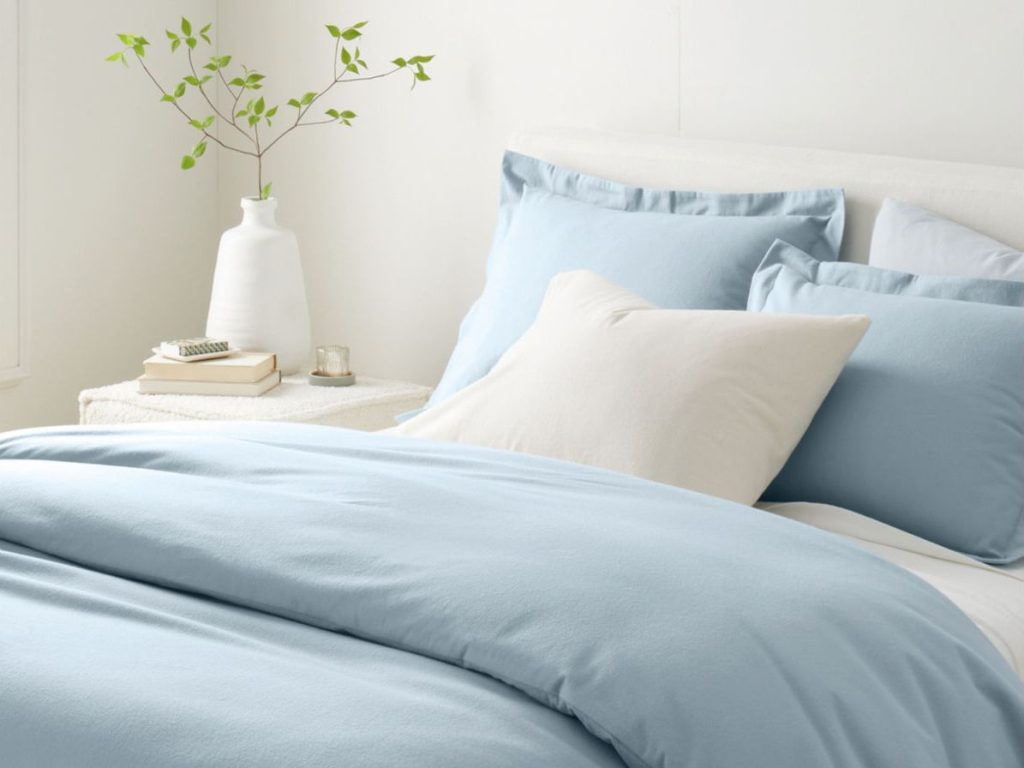
Flannel Sheets Review: Getting to Know the Pros and Cons
For many people, flannel sheets bring to mind images of cozy cabins and chilly winter
For many people, flannel sheets bring to mind images of cozy cabins and chilly winter nights. Their soft, plush feel makes them a popular choice for adding warmth and comfort to beds. But are flannel sheets right for you? In this flannel sheets review, we’ll look at the pros and cons to help you decide.
What Exactly Are Flannel Sheets?

Flannel sheets are made from a softly woven fabric that has been brushed on one or both sides to create a warm, fuzzy texture reminiscent of flannel clothing. They are typically made from fabrics like cotton, wool, or synthetic blends.
Authentic 100% cotton flannel offers the highest quality and durability. Avoid cheaper polyester flannel sheets, which pill and become less soft over time. High quality cotton flannel resists pilling and gets even softer with washing.
Pros of Flannel Sheets
Cozy Warmth
The main appeal of flannel sheets is their incredible warmth and coziness. The brushed nap traps air and creates excellent insulation to keep you toasty on cold nights. Flannel has a weightier, more substantial feel than other bedding fabrics. Slipping under a flannel sheet feels like wrapping yourself in a warm hug!
Soft Comfort
In addition to being deliciously warm, flannel sheets offer supreme comfort thanks to their soft, plush texture. The brushed finish makes them perfect for curling up in bed. Their softness even improves after washing.
Durability
High quality cotton flannel sheets are quite durable, resisting pilling far better than cheaper polyester options. With proper care, cotton flannel can last for many years. The fibers get softer over time rather than wearing thin.
Cons of Flannel Sheets
Heat Retention
Flannel’s exceptional warmth comes with a downside—it can cause overheating, especially for hot sleepers. Flannel traps a lot of body heat, so they may be uncomfortably warm in warmer bedrooms or seasons.
Pilling Potential
While good cotton flannel is quite durable, cheaper synthetic flannel is prone to pilling fairly quickly. This can make the sheets look old and ragged. Stick with high quality cotton to avoid extreme pilling issues.
Added Laundering
The brushed texture needs a bit of extra care when laundering. Avoid abrasive fabrics and high heat to prevent pilling. Stick to a mild detergent and lay flat to dry. The extra laundry care may be a hassle for some.
Weight
Flannel sheets have a substantially heftier feel and thickness than sheets made of fabrics like Egyptian cotton. Some people dislike the weight, especially in warmer weather when breathability is key.
When to Use Flannel Sheets

Cold Nights & Climates
Flannel sheets really shine in cold temperatures. If you live in a region with long, frigid winters or keep your home cooler at night, the warmth of flannel can’t be beat. The same goes for mountain cabins or other vacation properties in chillier climates.
Winter Months
Use flannel sheets seasonally to add cozy warmth on beds from around October to March when temperatures start dropping. Rotate them out for lighter linens in spring and summer.
Children & Babies
Kids love the soft, fuzzy feel of flannel. These sheets are perfect for keeping little ones warm and comfortable all night long.
Flannel Sheet Shopping Tips
- Choose 100% cotton over cheaper polyester options for best quality and durability.
- Buy pre-washed sheets to maximize softness and minimize shrinkage.
- Feel the weight and thickness to gauge quality. Better flannel has a heavier hand-feel.
- Read customer reviews to learn about softness, pilling issues, and durability.
- Buy twin XL for college dorm beds.
Flannel Sheet Care Tips
- Wash in cold water on a gentle cycle before first use and after that as needed.
- Use a mild, fragrance-free detergent.
- Never use fabric softener or dryer sheets to prevent pilling.
- Tumble dry low. Remove promptly to prevent wrinkling.
- Avoid ironing. Lay flat to dry for best results.
The Verdict: Should You Buy Flannel Sheets?
If you live in a colder climate or run chilly at night, the cozy warmth of flannel sheets makes them a fantastic choice for winter. The famously soft texture also feels heavenly against the skin. Just take care to choose high quality 100% cotton sheets and launder carefully. With proper expectations about their year-round functionality, flannel sheets can be a cozy addition to your bedding lineup.
Frequently Asked Questions
1. How often should flannel sheets be washed?
Wash cotton flannel sheets every 1-2 weeks, or as needed if they become dirty or sweaty. Avoid over-washing, as this can cause pilling.
2. Should flannel sheets be ironed?
Avoid ironing flannel sheets, as the heat can damage the fluffy brushed nap and cause pilling. Let them air dry flat instead.
3. What is the best thread count for flannel sheets?
Thread count isn’t as important with flannel sheets. Focus instead on the fabric quality and weight. Medium-weight 100% cotton flannel will be the most durable.
4. Are flannel sheets good for winter only?
Yes, flannel sheets are ideal for cold weather but can be uncomfortably warm for summer. Most people use them seasonally from fall through early spring.
5. How do I soften scratchy new flannel sheets?
Wash them once or twice on a gentle cycle to soften the fibers. Tumble dry low and avoid fabric softeners. The more you launder them, the softer they become.
You Can Also Read Here Warmool Heater Review: Does It Really Work?
